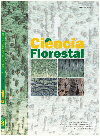
|
Ciência Florestal
Centro de Pesquisas Florestais - CEPEF, Departamento de Ciências Florestais - DCFL, Programa de Pós Graduação em Engenharia Florestal - PPGEF
ISSN: 0103-9954
EISSN: 0103-9954
Vol. 28, No. 2, 2018, pp. 495-504
|
 Bioline Code: cf18045
Bioline Code: cf18045
Full paper language: Portuguese
Document type: Research Article
Document available free of charge
|
|
|
Ciência Florestal, Vol. 28, No. 2, 2018, pp. 495-504
| pt |
INFLUÊNCIA DA MATOCOMPETIÇÃO EM POVOAMENTOS JOVENS DE Pinus taeda  L. L.
Pellens, Gabriel Corso; Lessa, Paulo Roberto; Schorn, Lauri Amândio & Fenilli, Tatiele Anete Bergamo
Resumo
O objetivo desse trabalho foi avaliar o comportamento e a correlação entre o desenvolvimento das mudas
de Pinus taeda e a matocompetição em áreas de reflorestamento ao longo de 24 meses, com a finalidade
de poder realizar o manejo adequado da matocompetição e reduzir o uso de agroquímicos. O delineamento
experimental utilizado foi de blocos ao acaso, com 8 tratamentos (controle de plantas daninhas com
herbicida glifosato em períodos diferentes) e 4 repetições, sendo: (testemunha sem controle, controle total
da matocompetição e controle da matocompetição aos 2; 4; 6; 8; 10 e 12 meses após o plantio das mudas no
campo). As dimensões das parcelas foram de 20 x 30 m (600 m²). Após a instalação do experimento, foram
avaliadas 24 mudas centrais do tratamento, quanto a: sobrevivência (%), altura (cm), diâmetro do colo (cm)
e o fator de produtividade (cm3), aos 6, 12,18 e 24 meses após o transplante das mudas para o campo. Com
base nos resultados, pode-se concluir que a sobrevivência e altura das mudas não foram influenciadas pelo
período de convivência entre as plantas daninhas e o seu controle, no entanto o diâmetro do colo e o fator
de produtividade foram influenciados pelo período de convivência e ainda que o período no qual ocorreu a
maior interferência das plantas daninhas as mudas jovens foram durante o primeiro ano de estabelecimento
da floresta.
Palavras-chave
plantas daninhas; reflorestamento; herbicida; silvicultura.
|
| |
| en |
INFLUENCE OF WEED COMPETITION IN YOUNG STANDS OF Pinus taeda  L. L.
Pellens, Gabriel Corso; Lessa, Paulo Roberto; Schorn, Lauri Amândio & Fenilli, Tatiele Anete Bergamo
Abstract
The aim of this work was to evaluate the behavior and the correlation between the development of loblolly
pine seedlings and weed competition in reforestation areas over 24 months in order to be able to make
the appropriate management of weed competition and reduce the use of agrochemicals. The experimental
design was a randomized block with 8 treatments (weed control with glyphosate herbicide at different
times) and 4 replications: (control without control, full control of the weed competition and control of weed
competition at 2, 4, 6, 8, 10 and 12 months after planting the seedlings in the field). The plot dimensions
were 20 x 30 m (600 m²). After installing the experiment, 24 central seedlings per treatment were evaluated
regarding: survival (%), height (cm), stem diameter (cm) and factor of production (cm³), at 6, 12, 18 and
24 months after transplanting the seedlings to the field. Based on the results, it can be concluded that
survival and seedling height were not affected by the period of coexistence between weeds and their control,
however the stem diameter and the factor of production (cm ³) were influenced by the coexistence period
once the period when occurred the largest weed interference in the young plants was during the first year
of the forest establishment.
Keywords
weed; reforestation; herbicide; silviculture
|
| |
© Copyright [2018] - Ciência Florestal
Alternative site location: http://cascavel.ufsm.br/revistas/ojs-2.2.2/index.php/cienciaflorestal/index
|
|
